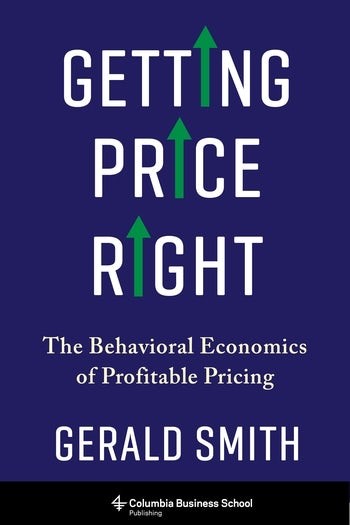How do you know when the price is right? What are some of the biases that drive decisions about pricing? In a new book, Carroll School of Management Associate Professor Gerald Smith (who also chairs the Marketing Department) mixes the academic with the actionable to answer those and other questions for managers, entrepreneurs, and business owners in need of smarter pricing strategies.
Released in October by Columbia University Press, the book is titled Getting Price Right: The Behavioral Economics of Profitable Pricing. Among other lessons, Smith pays attention to the soft skills of pricing (such as price framing, pricing strategy and “nudging”) as well as the hard skills (including value estimation and financial modeling). In Smith’s experience, the pairing of these skills leads to pricing that is more rational and ultimately successful—boosting not only revenue and profitability but also employee productivity and customer satisfaction.
Below are brief excerpts from the book, including a thumbnail sketch of hard and soft skills, and advice on thinking “fast and slow.”
Skills for Price Setters
“Soft pricing skills are usually memory-driven, relational, tacit, and heuristic. They involve automatic thinking and often begin as improvisational. They can also be biased, heuristic, and shortsighted. However, they can—with training, insight, and focus—be adapted into soft skills that sustain and refine pricing and lead to more holistic behavioral outcomes such as employee productivity, employee satisfaction, and customer satisfaction....
“Hard analytic price-setting skills are typically more systematic, such as customer value modeling, break-even sales calculations, or conjoint analysis. They are thus the opposite of soft pricing skills, but the two are complementary when used in combination. Hard analytic price-setting skills are data driven, procedural, methodical, and structured and involve slow deliberate thinking....
“Hard pricing skills can be challenging to learn and might be inaccessible and consequently ignored by many price-setters. One purpose of this book is to make these skills more accessible to everyday price-setters, even those with little background in business and with small and midsized firms.”
Thinking Fast and Slow
“In his seminal book, Thinking Fast and Slow, Nobel Prize winner Daniel Kahneman describes two modes of decision processing—known as System 1 processing and System 2 processing—which underlie recent findings of behavioral economists, psychologists, and sociologists. I will present these two, in reverse order, in terms of how they relate to price-setting....
“System 2 processing: analytic intelligence, algorithmic processing, cognitive control, and high demands on cognitive capacity. This relatively laborious process is the “slow” in Kahneman’s book title....
“A System 1 approach to decisions relies more on memory than on calculation. It is marked by automatic intuitive thinking using holistic cognition—which makes it much quicker and easier than System 2 processing. We see something and automatically access our memory to make memory-based intuitive judgments about what it is and is not, what it is like, what it is likely to do, how it feels, and how to respond.... System 1 processing is a matter of quickly jumping to solutions, which makes it fast—sometimes an efficient way to deal with an immediate situation—but not always accurate....
“Price-setting is by nature a quantitative task involving calculation, analytics, and controlled rule-based processing; that is, you naturally expect it to be a System 2 analytic task. However, in practice, price-setting is often approached not analytically but subjectively, more of a System 1 intuitive task that is driven by what you recall from memory quickly, such as a competitor’s price, or a quick pricing rule of thumb....
“In your own pricing environment, consider how goal framing can motivate employees and team members to do smart price-setting by leveraging System 1 behavioral impulses. Hedonic goal frames (for example, being awarded a stay at a resort) or gain goal frames (e.g., a cash spiff for making a sale) motivate price-setters in different ways. Then make sure your incentives align well with corporate normative goal frames to achieve profitability and group performance goals.... Ask yourself how you can frame goals to leverage System 1 behavioral advantages to nudge your price-setters into making fast decisions, repetitively and automatically, to the benefit of both the employee and your firm. It requires thoughtful design but usually leads to more profitable and more satisfactory pricing.”
Excerpted from Getting Price Right by Gerald Smith. Copyright (c) 2021 Gerald E. Smith. Used by arrangement with the Publisher. All rights reserved.
Ada Anderson '23, a publications assistant at the Carroll School, provided editorial assistance for this article.




